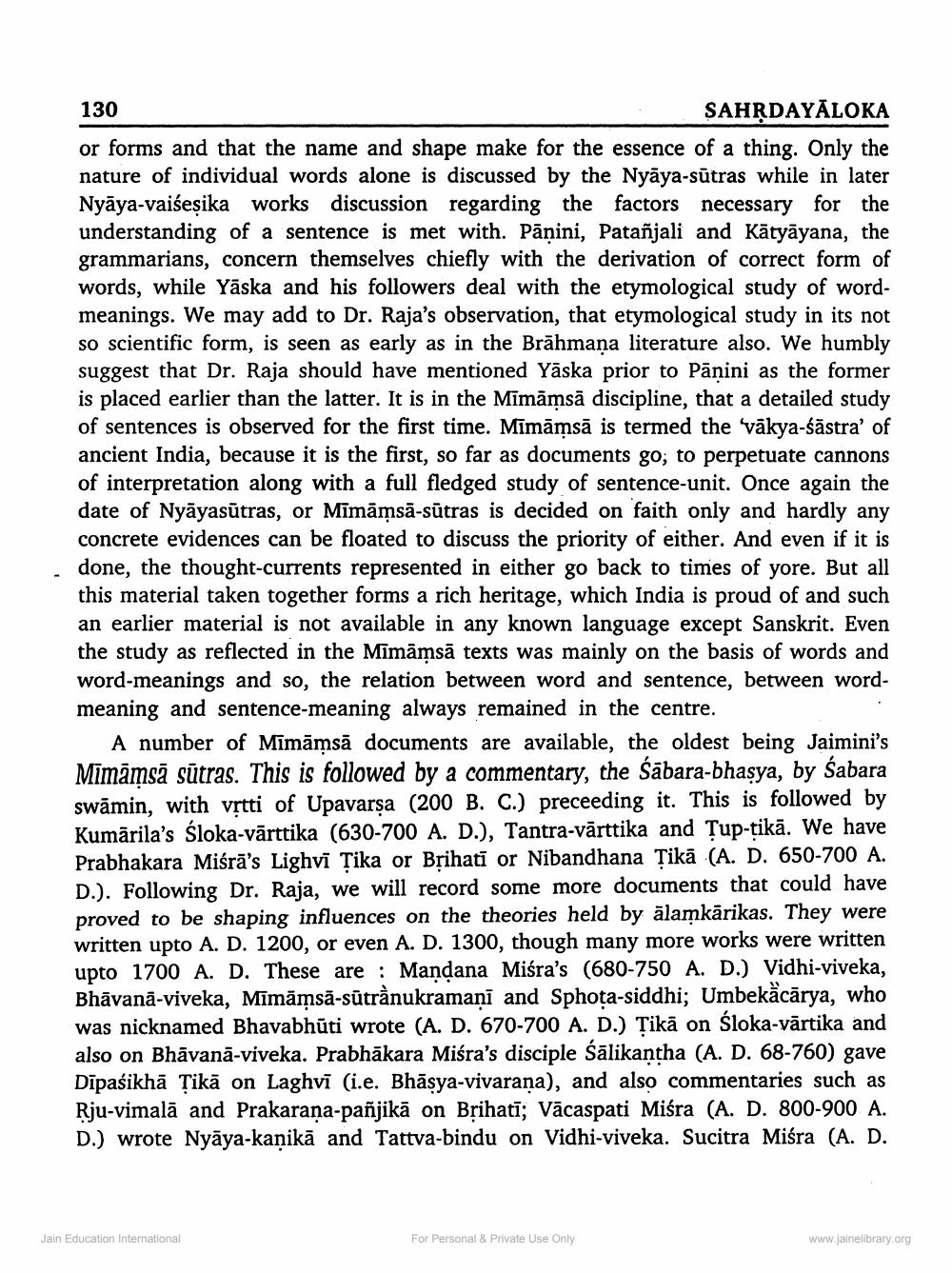________________
130
SAHRDAYĀLOKA or forms and that the name and shape make for the essence of a thing. Only the nature of individual words alone is discussed by the Nyāya-sūtras while in late Nyāya-vaisesika works discussion regarding the factors necessary for the understanding of a sentence is met with. Panini, Patañjali and Kätyāyana, the grammarians, concern themselves chiefly with the derivation of correct form of words, while Yaska and his followers deal with the etymological study of wordmeanings. We may add to Dr. Raja's observation, that etymological study in its not so scientific form, is seen as early as in the Brāhmaṇa literature also. We humbly suggest that Dr. Raja should have mentioned Yāska prior to Pānini as the former is placed earlier than the latter. It is in the Mimāmsā discipline, that a detailed study of sentences is observed for the first time. Mimāmsā is termed the 'vākya-śāstra of ancient India, because it is the first, so far as documents go, to perpetuate cannons of interpretation along with a full fledged study of sentence-unit. Once again the date of Nyāyasūtras, or Mīmāmsā-sūtras is decided on faith only and hardly any concrete evidences can be floated to discuss the priority of either. And even if it is done, the thought-currents represented in either go back to times of yore. But all this material taken together forms a rich heritage, which India is proud of and such an earlier material is not available in any known language except Sanskrit. Even the study as reflected in the Mimāmsā texts was mainly on the basis of words and word-meanings and so, the relation between word and sentence, between wordmeaning and sentence-meaning always remained in the centre.
A number of Mīmāmsā documents are available, the oldest being Jaimini's Mīmāmsā sūtras. This is followed by a commentary, the sābara-bhasya, by śabara swāmin, with vrtti of Upavarsa (200 B. C.) preceeding it. This is followed by Kumārila's śloka-vārttika (630-700 A. D.), Tantra-vārttika and Tup-tikā. We have Prabhakara Miśrā's Lighvi Tika or Brihati or Nibandhana Tikā (A. D. 650-700 A. D.). Following Dr. Raja, we will record some more documents that could have proved to be shaping influences on the theories held by ālamkārikas. They were written upto A. D. 1200, or even A. D. 1300, though many more works were written upto 1700 A. D. These are: Mandana Miśra's (680-750 A. D.) Vidhi-viveka, Bhāvanā-viveka, Mimāmsā-sūtrầnukramanī and Sphota-siddhi; Umbekā was nicknamed Bhavabhūti wrote (A. D. 670-700 A. D.) Tikä on śloka-vārtika and also on Bhāvanā-viveka. Prabhākara Misra's disciple Śālikantha (A. D. 68-760) gave Dīpaśikhā Tikā on Laghvi (i.e. Bhāsya-vivarana), and also commentaries such as Rju-vimalā and Prakarana-pañjikā on Brihatī; Vācaspati Miśra (A. D. 800-900 A. D.) wrote Nyāya-kanikā and Tattva-bindu on Vidhi-viveka. Sucitra Miśra (A. D.
Jain Education International
For Personal & Private Use Only
www.jainelibrary.org




